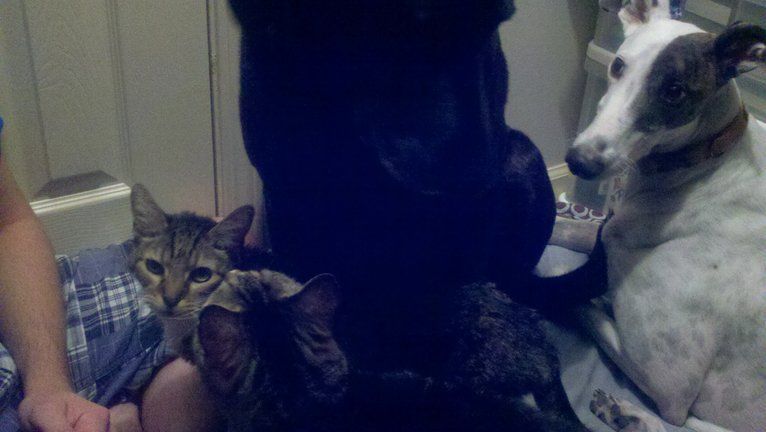 |
| Everyone all huddled together in the closet. Of course, Ebon's just a massive shadow |
Sunday, July 29, 2012
Storms
We had a tornado warning today and for the first time since I've moved to the condo the tornado sirens went off, as well as other alerts saying "take cover now." So, the significant other and I piled into my closet with Ebon, Siggy, and the two cats. Nothing hit us, but I couldn't help but be amused by what it was like to have all of us in such a small space. The last time I got a "take cover now" alert it was me, Ebon, and my mom's two cats in a bathroom. A bathroom larger than the closet at that, and I was dealing with the semi-feral Ginny not wanting anything at all to do with Ebon. Ah, thunderstorms.
Guess the Genotype #85
Can you guess this dog's genotype? Its breed?
 |
| Image is from Wikimedia Commons under a Creative Commons license |
Friday, July 27, 2012
More on the Dogs (and other things)
 |
| The boys politely eating together |
Anyway, I wanted to make a note about Ebon's food trials. I was bad and picked up some more food today: Go! Natural Grain Free. It was half off because the formula is being discontinued and I just couldn't help myself. It's dated sooner than the other foods I have, so it will be next in line to be reviewed. The bag is also only six pounds, so this will be sort of a mini review.
I've also been trying out a number of canned foods, which eventually will be lumped into one mega review later. One of the main reasons for this is I picked up a lot of cans because the same place that had the kibble mentioned above on sale is also no longer going to be selling certain brands of canned food. It's hard for me to pass up a sale.
For now, I'll end with a picture of Siggy trying to sleep in Ebon's kennel.
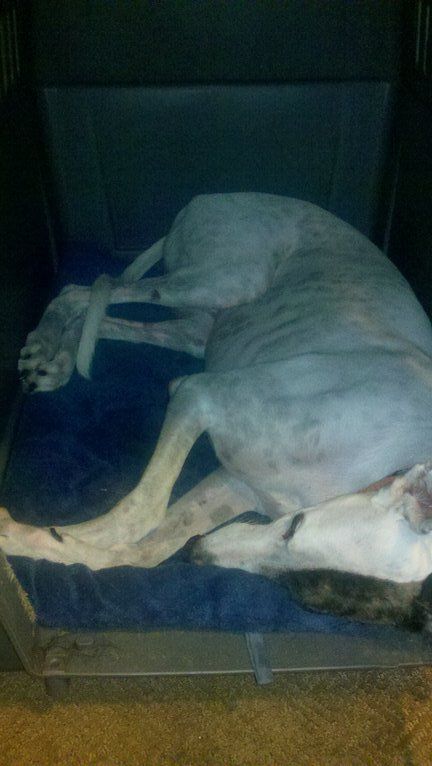 |
| He just doesn't fit |
Thursday, July 26, 2012
Dog Food Review: Innova
This is the eighth of the dog food review series I'm doing. The formula of this food is changing, so this review will be obsolete once the old formula is no longer being sold.
I forgot to take pictures again, so no photos this time.
Innova Adult Dry Dog Food - Large Bites
Dog Food Advisor rating: ★★★★☆
This food is AAFCO approved for all life stages.
Items in italics will be discussed later.
Bag's recommended daily feeding for a dog 80 lbs: 2 3/4 cups
Crude Protein: minimum of 24.0%
Crude Fat: minimum of 14.0%
Crude Fiber: maximum of 2.5%
Moisture: maximum of 10.0%
Calorie content: 504 kcal/cup, 3,694 kcal/kg
Calculated amount to maintain Ebon's ideal weight (82.5 lbs): 3.31 cups or 0.45 kg (0.99 lbs)
- Innova has its own calculator, which advises 3.125 cups/day
Price per pound when buying the largest bag (30 lbs at $49.99): $1.6663
Estimated cost of feeding Ebon per year on this food: $602.12 (12.045 of the 30 lb bags)
Ebon receives slightly less than the calculated feeding amount to allow for his daily treats
Ebon's overall health on this food: Very good. Shiny coat, poop consistent, energy level moderate to high.
I would have to say Ebon's experiences with this food were, well, average. There's nothing really remarkable to report, either good or bad. He was pretty typical, everything doing fine. As I mentioned above, his energy level was typical for him, as were his coat and stool consistency. There were no bad traits that I noticed when he was on foods that were of poorer quality or that he didn't respond well to. He gained a bit of weight on this food, but I think that's mostly due to him sneaking some food from the other animals. Siggy and my brother's cats are messy eaters, and Ebon is definitely an opportunistic eater if given the chance. Siggy tends to grab a mouthful and chew with at least a kibble or two falling out of his mouth each time he does so. Ebon will actually stop eating his own food to pick up the dropped kibble, then go back to eating his own food. He got bold enough from doing this that he tried to take Siggy's peanut butter-laced Kong one day, which ended up with a growl that sent Ebon scurrying from the room. He's been respectful ever since, but is still a kibble thief if I don't watch him.
As those who have read these reviews before know, Ebon's stools become soft when he's stressed. It seems like his stress poops were softer than average on this food, but it may seem that way partly due to him being more stressed than average during this trial. Siggy's been visiting and his whines and barks when he's needy seem to stress Ebon out. He's a quiet dog himself and we live rather quiet lives, so any sort of unusually loud atmosphere is unsettling to him if he's not used to it. Luckily, he seems to be getting used to it as his stress behaviors, including the stress poops, were basically gone after about a week. Progress is always good. Ironically, though Ebon seems to find Siggy boisterous, Ebon is by far the more rambunctious of the two dogs. He just isn't very vocal, besides barking at the doorbell.
Will I change foods? We'll see. Next up: California Natural.
Wednesday, July 25, 2012
Guess the Genotype #84
Can you guess this litter of puppies' genotypes? Their breed?
 |
| Image is from Wikimedia Commons under a Creative Commons license |
Cool Animal Sounds: Bald Eagle
It seems that virtually everyone living in the United States is enamored by the bald eagle. However, it's amazing how few people actually know what our national bird sounds like! It doesn't help that filmmakers have, in the past, dubbed the calls of other raptors over those of the eagles. This is probably because bald eagles, though beautiful to look at, don't exactly sound very impressive. For their size, they have surprisingly quiet calls. I've heard someone say the bald eagle sounds like a squeaky toy, and I must say this description does fit surprisingly well.
Video is from YouTube.com.
Video is from YouTube.com.
Monday, July 23, 2012
Unusual Breed: Český Fousek
 |
| This breed is also known as the Bohemian Wire-haired Pointing Griffon |
 |
| "Fousek" refers to the beard |
The Český fousek is an all around working dog, able to track, point and retrieve over land and in water. They have a high working drive, and the breed's trainability is one major reason why they are so popular in the Czech Republic. They are also gentle and social, making them rather good family dogs.
The coat is wiry and the color is liver, with or without roan, including dogs that are mostly roan. In appearance, there is at least some resemblance to the other liver roan pointing breeds, such as the German wirehaired pointer, wirehaired pointing griffon, and Stichelhaar. Due to the breed's versatility, it is beginning to become more popular outside of its native country.
Sources are the Fédération Cynologique Internationale. Pointing Dog Blog, Klub chovatelů českých fousků, and Venaticus Major. Google translate used for pages not in English. Images are from Wikimedia Commons or Flickr.com under Creative Commons licenses: one, two.
Sunday, July 22, 2012
So, what is Fur Anyway?
 |
| Pet owners are usually well aware of how abundant fur can be |
 |
| Human hair |
As we all know, hair is something that only mammals have. It serves some of the same purposes as scales and feathers, but is definitely unique. The main function of hair is insulation and thus temperature regulation, which is vital for endotherms to maintain homeostasis. Interestingly enough, scientists haven't been able to pinpoint when it evolved, including whether endothermy or hair were first on the scene.
 |
| Anatomy of a hair follicle |
 |
| Hair structure |
Now, let's move on to types of hair. There are more than you might have originally thought. There are two basic types of hair with more specific types fitting into one of the two. Angora hair is hair that never stops growing and which may or may not shed. This would be what humans have on their heads, what horses have in their mane, and what certain breeds of dog have all over their bodies. In contrast, there's definitive hair, which will only grow so long and which shed and re-grow regularly. This would be what's on the body of a cat and most dogs. Within angora and definitive hair, there are a number of other relevant hair categories, and this is where it starts to get complicated.
 |
| Vibrissae on rats, along with pelage |
 |
| Horses have numerous types of hair: vibrissae, pelage (both guard hair and undefur), and bristles |
Source is Mammalogy: Adaptation, Diversity, Ecology. Images are from Wikimedia Commons and are under Creative Commons licenses or are copyright free: one, two, three, four, five, six.
Friday, July 20, 2012
Guess the Genotype #83
Can you guess this dog's genotype? Its breed?
 |
| Image is from Flickr.com under a Creative Commons license |
How to Calculate your Dog's Cephalic Index
 |
| Dogs have heads that vary a lot in size and shape |
For the skull width, gently feel between the dog's eye and ear. You should find a bar-shaped bone: the zygomatic arch. This projects out from the skull over the jaw muscles on either side of the head. Since dogs have rather strong jaw muscles, this will always be the widest part of the skull. If you're curious, check it out. Feeling under the ears will reveal a smaller skull width than what is seen at the zygomatic arch. To measure the skull width, don't simply lay a tape measure from zygoma to zygoma. Since the skull isn't flat, this will give you a falsely large measurement. This is why calipers are usually used to make these measurements. You can jerry-rig a set of calipers using two straight objects and a ruler, but this is difficult and there are easier ways to do it, which I will discuss later.
For the skull length, find the body protrusion on the back of the skull: the occiput. It should be fairly simple to find, sitting between the ears and often very close to where the head meets the neck. The prominence of this can vary a lot by breed, so if you have a dog with a very round skull you may not be able to find it. If this is the case, take the measurement from the farthest protruding part of the skull you can find. Measure from this point to the tip of the nose.
What would be the easiest way to get these measurements? Well, a lot of dogs would probably not be very happy with you messing with their head, so an alternate method of finding these measurements is using pictures. If you take a photograph of your dog's head from above, you can use this to measure the CI. Units don't matter, so you can use one measurement to figure out the other. Here's me doing this with Ebon:
Width is one unit and length is two and eight-one hundredths units. So, after calculating the CI ((1 x 100)/2.08), I found out that Ebon has a cephalic index of just slightly over forty-eight. This is really rather small, definitely less than seventy-five, and makes him dolichocephalic (for those that are curious, my dad's greyhound, Siggy, has a CI of 44.6). Now, I'll calculate the index for a bulldog:
The length is one unit and the width is one and fifty-five-hundredths. After calculating the CI ((1.55 x 100)/1), I found that this bulldog has a cephalic index of one hundred fifty-five. This is rather ridiculously large since the scale usually only goes to one hundred, and may be off as the dog's head is somewhat tilted. Either way, this dog is most definitely hyperbrachycephalic as his CI is far over eighty-five.
So, can you calculate your dog(s)' cephalic index? If you do, let me know what you come up with.
The First and third images are from Wikimedia Commons. The first is under a Creative Commons license and the third is copyright free. The second image is mine.
Thursday, July 19, 2012
Hairless Breeds and Skin Color
I was recently asked by a confused reader about what sort of link there is between skin color and hair color in hairless breeds. In breeds like the Chinese crested, it's not uncommon for a dog with dark skin to have pale hair. In other cases, the skin matches the hair. So, what causes this? To answer this, I'm going to look at a number of dogs and discuss the genes that are likely causing their hair and skin colors. First, though, some notes.
As a general rule, the darkest skin color should match the black pigmentation that would be seen in the coat. Patches of pink skin, whether spotted or not, represent what would be white markings on a dog with a full coat. By taking into account these characteristics, plus what's seen in whatever hair the dog happens to have, you can get a pretty good approximation of what genes are causing the dog's appearance.These rules don't always work, but I'll try to explain these exceptions.
This dog is really straightforward and a good place to start. It has minimal white and its skin matches its hair almost perfectly. In this case, the dog is black. Probably dominant black (K-). The white that is seen includes markings on all four paws, the chest, neck, and a bit on the face. This fits with minimal Irish markings (sisi) and would cause a dog with fur to look kind of like this.
This dog is also black, but clearly there is more going on here. Instead of having very little white, this dog has a lot of it. This explains all of the pink skin and white hair. In fact, it appears that this dog is extreme white (swsw), which results in a dog who is almost completely white. If this dog had a full coat it would look rather like this. Since this dog has so few spots, it probably doesn't have a copy of the ticking gene.
This dog is almost identical to the dog above with one notable difference: spots! White the dog above has almost no spots on its skin, this dog has a lot of them. It's quite possible that this dog has a copy of the ticking gene, but this isn't necessarily the case. Most dogs with white markings will have at least some skin spots, but more spots are seen in dogs with ticking. This dog is rather a lot like my dad's greyhound, Siggy, whose skin spots overwhelm his red ticking spots because his fur is so thin.
This dog is expressing something a bit different. Thought its skin is pink, this is due to something other than a white gene. This dog is sable (Ay-), which explains the dark tips on its hair. The skin color on sable dogs can vary from completely matching the color of its nose to something like this. In dogs like this, the nose, eye rims, and paw pads would be dark, but the predominant skin color is actually pink. If there are any white markings on the dog, it would be difficult or maybe even impossible to tell. If this dog had fur, it would look kind of like this.
You can also find a number of dogs that look like this. Clearly, the dog's skin and hair are completely different colors. This dog is most likely a recessive red (ee) that's been diluted down to white. Recessive red is a gene that doesn't allow any black in the coat, so it can hide a lot of different colors. This appears to be a common color in the breed, probably due to the flashy appearance of pale hair on a dark body. In cases like this, the dog is probably black behind the recessive red, which would explain the dark skin. As before, the spotted areas are white markings, which are basically indistinguishable from the pale color of the rest of the hair. If this dog had fur, it would look somewhat like this.
For simplicity's sake, I will end with this dog. This dog again has two skin colors, but both of them are pale. Unlike the dogs before who have black pigment, this dog's pigment has been diluted down. Since its skin is so pale, I suspect that it's expressing both the blue (dd) and liver (bb) genes, making it fawn or Isabella. I have actually heard of cresteds that are this sort of color being called palomino which is an...interesting way of looking at it. The genes behind horse color are completely different from those behind dog color, so those sorts of naming schemes don't make sense to me. Anyway, the fawn coloration doesn't just change a dog's coat color, but it also dilutes down the skin color. In combination with this, the dog is also expressing the recessive red gene. This explains why it has white hair. If this were not true, the hair would be similar in color to the skin,and the dog would look more like this.
Images are from Wikimedia Commons and Flickr.com under Creative Commons licenses: one, two, three, four, five, six.
As a general rule, the darkest skin color should match the black pigmentation that would be seen in the coat. Patches of pink skin, whether spotted or not, represent what would be white markings on a dog with a full coat. By taking into account these characteristics, plus what's seen in whatever hair the dog happens to have, you can get a pretty good approximation of what genes are causing the dog's appearance.These rules don't always work, but I'll try to explain these exceptions.
This dog is really straightforward and a good place to start. It has minimal white and its skin matches its hair almost perfectly. In this case, the dog is black. Probably dominant black (K-). The white that is seen includes markings on all four paws, the chest, neck, and a bit on the face. This fits with minimal Irish markings (sisi) and would cause a dog with fur to look kind of like this.
This dog is also black, but clearly there is more going on here. Instead of having very little white, this dog has a lot of it. This explains all of the pink skin and white hair. In fact, it appears that this dog is extreme white (swsw), which results in a dog who is almost completely white. If this dog had a full coat it would look rather like this. Since this dog has so few spots, it probably doesn't have a copy of the ticking gene.
This dog is almost identical to the dog above with one notable difference: spots! White the dog above has almost no spots on its skin, this dog has a lot of them. It's quite possible that this dog has a copy of the ticking gene, but this isn't necessarily the case. Most dogs with white markings will have at least some skin spots, but more spots are seen in dogs with ticking. This dog is rather a lot like my dad's greyhound, Siggy, whose skin spots overwhelm his red ticking spots because his fur is so thin.
This dog is expressing something a bit different. Thought its skin is pink, this is due to something other than a white gene. This dog is sable (Ay-), which explains the dark tips on its hair. The skin color on sable dogs can vary from completely matching the color of its nose to something like this. In dogs like this, the nose, eye rims, and paw pads would be dark, but the predominant skin color is actually pink. If there are any white markings on the dog, it would be difficult or maybe even impossible to tell. If this dog had fur, it would look kind of like this.
You can also find a number of dogs that look like this. Clearly, the dog's skin and hair are completely different colors. This dog is most likely a recessive red (ee) that's been diluted down to white. Recessive red is a gene that doesn't allow any black in the coat, so it can hide a lot of different colors. This appears to be a common color in the breed, probably due to the flashy appearance of pale hair on a dark body. In cases like this, the dog is probably black behind the recessive red, which would explain the dark skin. As before, the spotted areas are white markings, which are basically indistinguishable from the pale color of the rest of the hair. If this dog had fur, it would look somewhat like this.
For simplicity's sake, I will end with this dog. This dog again has two skin colors, but both of them are pale. Unlike the dogs before who have black pigment, this dog's pigment has been diluted down. Since its skin is so pale, I suspect that it's expressing both the blue (dd) and liver (bb) genes, making it fawn or Isabella. I have actually heard of cresteds that are this sort of color being called palomino which is an...interesting way of looking at it. The genes behind horse color are completely different from those behind dog color, so those sorts of naming schemes don't make sense to me. Anyway, the fawn coloration doesn't just change a dog's coat color, but it also dilutes down the skin color. In combination with this, the dog is also expressing the recessive red gene. This explains why it has white hair. If this were not true, the hair would be similar in color to the skin,and the dog would look more like this.
Images are from Wikimedia Commons and Flickr.com under Creative Commons licenses: one, two, three, four, five, six.
Siggy and Ebon
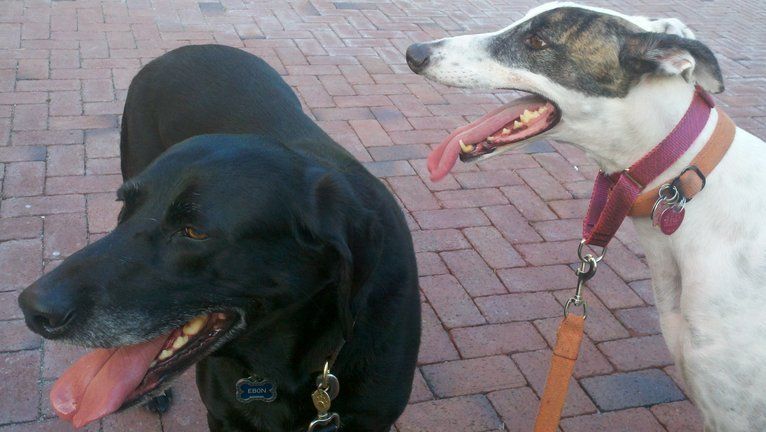 |
| Tired puppies during a water break |
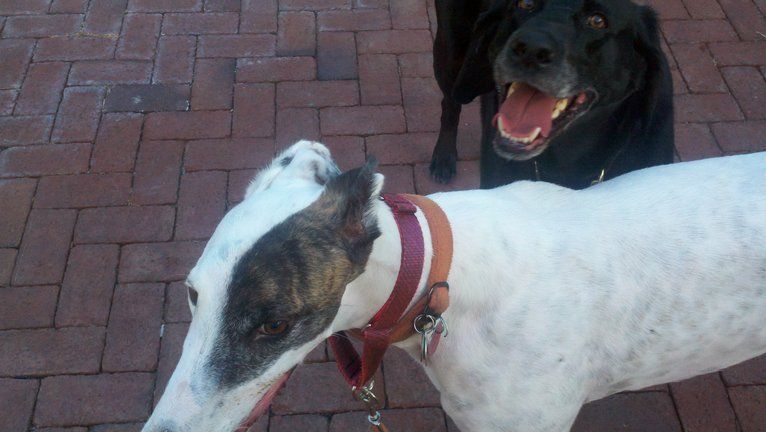 |
| Silly boys. Shows a bit more of their typical behavior. Ebon: super happy and hyper. Siggy: mellow as all get out. |
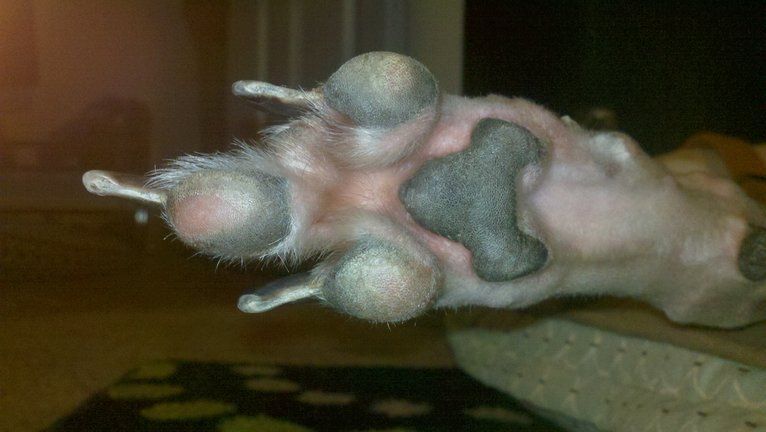 Also, if you're curious, here's what Siggy's foot with the amputated toe looks like from below. He has a wear spot on his center pad because of a combination of the missing toe and the stiffness he has in his other leg. Apparently, it's common for that leg to become arthritic because of the way the tracks are set up. The only turn in one direction, after all. Overall, the lack of toe doesn't hamper him very much. He can still run really well, and has chased after Ebon on more than on occasion, outpacing him like it was nothing.
Also, if you're curious, here's what Siggy's foot with the amputated toe looks like from below. He has a wear spot on his center pad because of a combination of the missing toe and the stiffness he has in his other leg. Apparently, it's common for that leg to become arthritic because of the way the tracks are set up. The only turn in one direction, after all. Overall, the lack of toe doesn't hamper him very much. He can still run really well, and has chased after Ebon on more than on occasion, outpacing him like it was nothing.We stopped by one of the pet stores after the walk and I was amused when a cashier asked their ages and was really surprised Ebon was the elder of the pair. I suppose it's mainly because of the vast difference in energy level.
Wednesday, July 18, 2012
Guess Who's Visiting
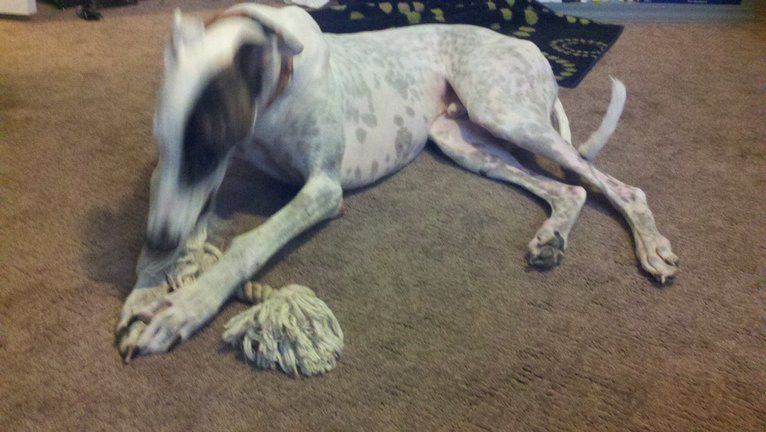 |
| Siggy! |
 |
| The boys |
It was kind of odd picking up his gear. For example, I have his muzzle (it's greeeen) and I have never used a muzzle before. It's nice to have it just in case, though. I'm going to need to cut his nails while he's here so I'll probably be making use of it at least once since he doesn't like having his paws messed with. I know it's a good idea to have a muzzle for your dog just in case, but I don't know...I've never felt the need with Ebon. I've been through a fair amount with him, including the whole seizure thing, but he's not a biter. He doesn't even nip. If he gets upset he do this startled look, but doesn't even try to bite. Anyway, it's easy to make a temporary muzzle out of a leash in a pinch so I'm not that worried about it.
I would really love to get a greyhound when I can (namely when I'm in a place with a fenced yard so the dog can run), so this is almost like a sort of trial run. It's such a contrast, especially when it comes to things like Siggy's counter surfing. If I tell Ebon no, he'll leave stuff alone. Siggy has to be pushed away before he'll consider leaving it. Pretty normal for retired racers, though.
Tomorrow, weather permitting, I plan to take the dogs to a park. We'll see how that goes.
Monday, July 16, 2012
Guess the Genotype #82
Can you guess this dog's genotype? Its breed?
 |
| Image is from Wikimedia Commons under a Creative Commons license |
Sunday, July 15, 2012
Saturday, July 14, 2012
Cool Animal Sounds: Victoria Crowned Pigeon
When I posted about this beautiful species of pigeon yesterday, I read about their somewhat interesting vocalizations but didn't bother to do some searching to find out if I could have a listen. Well, today I checked out the calls of this blue bird. Their mating display, as described in the post, involves bobbing of the head and tail accompanied by a very low, booming sort of call, sometimes described as a boom-pa call. However, since these birds are fairly small, they can't boom like some other species.
Bird mating displays are always fascinating.
Bird mating displays are always fascinating.
Friday, July 13, 2012
Interesting Animal: Victoria Crowned Pigeon
 |
| A Victoria crowned pigeon (Goura victoria), showing off its flashy crest |
 |
| Strutting pigeon |
The species is currently considered Threatened and their numbers are declining. Due to its beauty, it is hunted for its feathers. It is also eaten, either as a result of hunting or capturing of nestlings which are then raised for food. Apparently, it's very hard to hunt the birds if you don't use a shotgun due to their flight distance. In New Guinea at least, shotguns aren't really available. Of course, efforts are being undertaken to work on helping keep the species around, which include such efforts as encouraging ecotourism.
Sources are ARKive, Bristol Zoo Gardens, Bird Life International, and the IUCN Red List. Images are from Wikimedia Commons under Creative Commons licenses: one, two.
Thursday, July 12, 2012
The Cephalic Index
 |
| Skulls that are brachycephalic and dolichocephalic, respectively |
|
|
|
 |
| Technically brachycephalic |
In a series of posts to come, I will be discussing more about the cephalic index in dogs and why it can be so important.
Sources are Scientific Electronic Library Online, Encyclopedia Britannica, Encyclo Online Encyclopedia, . Images are from Wikimedia Commons and are under Creative Commons licenses or are copyright free: one, two, three, four, five, .
Tuesday, July 10, 2012
Guess the Genotype #81
Can you guess this dog's genotype? Its breed?
 |
| Image is from Wikimedia Commons under a Creative Commons license |
Monday, July 9, 2012
Mismark Case Study: Cavalier King Charles Spaniel
 |
| According to the AKC, Cavaliers come in four allowable colors, three of which are seen here: Blenheim, tricolor, and ruby. Black and tan is not shown. |
- Incorrect white
- Too much white on the face of a Blenheim or tricolor
- Any white on a ruby or black and tan
- Ticking
- On a Blenheim or tricolor
- Incorrect tan
- Seen on tricolors and black and tans
- Incomplete pigment
- Of the nose or eye-rims on a Blenheim or tricolor
- Blue eyes
- Usually only seen on a Blenheim or tricolor
 |
| White on a black and tan |
 |
| Too much white, lacking pigment |
 |
| Heavy ticking, too much white |
 |
| Incorrect tan on the face |
All of the mismarks that are seen in the Cavalier King Charles spaniel are really rather minor things that are to be expected from normal canine color inheritance. As such, they are nothing more than silly aesthetic preferences and do not reflect on the quality of the dog. Since this breed is a very common pet and, indeed, bred to be a companion, temperament and health should be far more important than what the dog looks like. Looks should never take precedence over these other, far more important traits. As such, color standards are really rather silly things based on nothing more than minor aesthetic preferences of the few people that wrote the standard. As the differences I have mentioned have absolutely no effect on the quality of a dog, eliminating a dog from the gene pool simply because it does not fit the color standard is ridiculous. Also, as purebreds are bred in closed registries, dropping any dog from the pool of potential mates makes it quite possible, and indeed likely, that a negative loss of genetic diversity will result. Since the color standard has also lead to color class breeding in the Cavalier, this is even more problematic.
Images are from Wikimedia Commons and Flickr.com under Creative Commons licenses: one, two, three, four, five.
Sunday, July 8, 2012
Crazy Plants: White Baneberry
 |
| The white baneberry (Actaea pachypoda) is also known as the doll's eye |
 |
| Ripening berries |
As I was taught as a child: never ever eat white berries as they are almost invariably toxic. This rule holds true for the white baneberry, where eating as few as five of the fruits will make you very ill and eating more than that can potentially kill you. Though tea was once made from the plant's roots as a folk remedy, every part of this plant is toxic and thus should be avoided. Symptoms following ingestion include a burning sensation in the throat and mouth, headache, dizziness, salivation, hallucinations, stomach cramps, and diarrhea.
 |
| Flowers |
This plant is currently listed as Threatened in New York and Endangered in Florida. It is common in many other areas of its native range.
Sources are the United States Department of Agriculture, University of Texas at Austin Ladybird Johnson Wildflower Center, Ontario Wildflowers, and Skidmore College North Woods Wiki. Images are from Wikimedia Commons under Creative Commons licenses: one, two, three.
Friday, July 6, 2012
Interesting Animals: Chinese Giant Salamander
 |
| A Chinese giant salamander (Andrias davidianus) in Germany |
 |
| A giant salamander in Shanghai |
The waterways these creatures live in are being threatened thanks to runoff from farming and deforestation. This brings pollutants as well as silt, which have lead to both a decrease in population size, but also a decrease in the average body size of the species. The change in population over the past thirty years has been described as "catastrophic." Once common, these strange amphibians are now quite rare. Attempts are being made to save the species, but populations are currently decreasing. Estimated generation time if fifteen years, so any increases in population size, if any, will take some time to become noticeable.
Sources are the ARKive, IUCN Red List, and EDGE. Images are from Wikimedia Commons under Creative Common licenses: one, two.
Wednesday, July 4, 2012
Guess the Genotype #80
In the spirit of patriotism, today's GtG dog apparently loves the USA. Can you guess this dog's genotype? Its breed?
 |
| Image is from Flickr.com under a Creative Commons license |
Phylum Rotifera
 |
| Colonial rotifers from a lake in Germany |
Rotifera comes from the Greek for "wheel bearer," and reflects one of the common names: wheel animals. This rather unusual-sounding common name comes from the ciliated corona that surrounds the mouth and is used to capture food. Due to cilia action, the corona appear to rotate like wheels when viewed under a microscope. There are approximately 1850 species known, with the vast majority of those species being found in freshwater. These animals are actually a common sight in pond water samples, especially those with a fair amount of debris. Samples of lake and pond average between forty and five hundred rotifers per liter. Most rotifers are free living, with parasitism being unusual in this phylum. Though some species are colonial, most are not. They aren't long-lived animals, with five weeks being an unusually long lifespan and one or two weeks being more typical.
 |
| The mastax is seen in the middle left |
Rotifers were one part of the former Phylum Aschelminthes which has since been broken down into several smaller groups. One characteristics that almost all of the aschelminths share is a developmental trait known as eutely. Eutely is when cells stop dividing at a certain point in development and any further growth in the size of the animal happens because the cells that are present increase in size.
 |
| Looping movement in some rotifers |
The cementing substance that is secreted by the toes can also be used in the form of movement seen at left, where a combination of muscular contractions and attachment at the toes will draw the animal across a surface. This method is often called looping due to the body's resemblance to a U-shaped loop. This form of movement does not require swimming via the corona.
 |
| A member of Class Bdelloidea |
Source is Biology of the Invertebrates. Images are from Wikimedia Commons and are under Creative Commons licenses or copyright free: one, two, three, four.
Subscribe to:
Posts (Atom)












